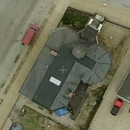Vapor open roof assembly insulated at the rafter level
Hi all,
I am in the process of replacing my roof on an 1870s brick home in the lower Midwest (Zone 4A, right on the border with 5A). Coldish winters and humid summers. The roof is a mansard, with a sloped section and a flat section. I have attached pictures. It is reasonably complicated with three dormers, a turret, and two octagonal bays. I have read many of the materials on ways to insulate at the rafter level or above.
I have seen less information, particularly in the US, about how vapor open assemblies perform. We will replace the sloped portion of the roof with slate. The flat portion will be standing seam metal, and we plan on using a vapor permeable underlayment (like Solitex Mento).
Insulation for the flat part of the roof is straight forward. We will put 4″ rigid mineral wool directly above the roof deck.
The sloped portion of the mansard is more difficult. It can’t really be vented – there are no eaves, and thus no soffits, so the roof terminates directly at the wall and you’d have to engineer an outlet vent of some kind at the joint between the sloped and flat portion to get airflow. Insulating on top of the roof deck would run afoul of the historical commission.
My thought would just be dense pack the rafter cavities with sheeps’ wool, for its performance while wet and hygroscopic properties, put rigid board across the rafters to address thermal bridging, and then apply a Pro Clima Intello membrane on the interior side of the rigid insulation to limit moisture escaping in the winter without compromising the ability of the rafters to dry to the inside.
This approach seems to be done often in England. The idea is that the roof can dry to both sides, and so any condensation that forms will be able to dry out. The roof decking is true 1″ thick Northern White Pine and quite sturdy stuff.
Anyone have any thoughts or experience with this sort of assembly? We are against CCSPF, which I know is the typical solution in our circumstances, for both environmental and preservationist reasons.
GBA Detail Library
A collection of one thousand construction details organized by climate and house part











Replies
Slate tile is self venting plus you also have a lumber roof deck with a lot of gaps which is great for moisture movement. As long as you use a vapor open underlayment for the slate, you can insulate the rafters with any type of fluffy insulation. The only issue is if somebody replaces the slate with shingles down the road. I guess that becomes somebody else's problem, the best problem to have.
Since the roof is vented, there is nothing wrong with adding interior insulation + smart VB. It should work great.
The hard part with a complicated roof is getting a decent air seal. Make sure to deal with this first. All those intersections and knee walls are air leak nightmares. Even the best vented roof can fail if air leaks are not dealt with.
Thanks for the response. I'm concerned about the air sealing too. What're your thoughts about how to detail the transition from the sloped part to the flat roof?
We're building a cornice with a drip edge on the exterior. The plan is to put 4" of rigid insulation (mineral wool), and battens for the standing seam metal on the flat part. I guess we'd put the rigid insulation on first, wrap everything with underlayment, and then fasten the cornice and battens through the underlayment. The height of the added rigid insulation might make attaching the cornice tricky. Unlike the slate, though, I wonder if the metal will be able to dry effectively to the exterior if we just put fluffy insulation in between the rafters.
As for the interior, the real tricky part will be getting the turret sticking out through the top of the roof in between the two bays. Figure it will just be a lot of tape and caulk to get this air tight.
I don't think you can run metal roof at that low of a slope. There are some commercial seamed setups but they tend to be quite bulky and ugly. You might need to bump up the slope a bit. The flat part doesn't need to be vented but you do need a vapor and air barrier directly under the rigid insulation.
In 4a, you only need 30% of your roof R value as exterior rigid for condensation control. Assuming 2x6 rafters, that is only ~R9 of rigid.
The most robust assembly would be to cover the whole roof with about R9-R15 of rigid nail base and install your new roofing on that. This way you can detail the existing roof deck as your air barrier which simplifies your overall air sealing. No need for any venting or interior rigid and you can dense pack the rafters without any issues.
After that, the next solution is SPF.
Since it sounds like that is off the table, you are only option is something that requires a lot of care and a lot of elbow grease.
I would start by having an engineer look at which knee walls are load bearing and remove any that are not. Simply taking out the knee walls in attics makes a huge difference on how big the space feels. Besides making the space feel bigger it lets you keep your air barrier continuous from 2nd floor wall plate up to the ceiling, across and back down.
The floor joist/rafter intersection is very hard to air seal properly, this is one area where a bit of SPF will make your life a lot simpler. Same with the turret.